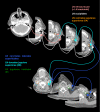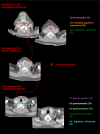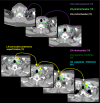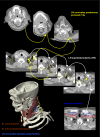Guidelines for delineation of lymphatic clinical target volumes for high conformal radiotherapy: head and neck region
- PMID: 21854585
- PMCID: PMC3178490
- DOI: 10.1186/1748-717X-6-97
Guidelines for delineation of lymphatic clinical target volumes for high conformal radiotherapy: head and neck region
Abstract
The success of radiotherapy depends on the accurate delineation of the clinical target volume. The delineation of the lymph node regions has most impact, especially for tumors in the head and neck region. The purpose of this article was the development an atlas for the delineation of the clinical target volume for patients, who should receive radiotherapy for a tumor of the head and neck region. Literature was reviewed for localisations of the adjacent lymph node regions and their lymph drain in dependence of the tumor entity. On this basis the lymph node regions were contoured on transversal CT slices. The probability for involvement was reviewed and a recommendation for the delineation of the CTV was generated.
Figures











Similar articles
-
Selection and delineation of lymph node target volumes in head and neck conformal radiotherapy. Proposal for standardizing terminology and procedure based on the surgical experience.Radiother Oncol. 2000 Aug;56(2):135-50. doi: 10.1016/s0167-8140(00)00202-4. Radiother Oncol. 2000. PMID: 10927132 Review.
-
Rotterdam and Brussels CT-based neck nodal delineation compared with the surgical levels as defined by the American Academy of Otolaryngology-Head and Neck Surgery.Int J Radiat Oncol Biol Phys. 2004 Jan 1;58(1):113-23. doi: 10.1016/s0360-3016(03)01453-6. Int J Radiat Oncol Biol Phys. 2004. PMID: 14697428
-
Guidelines for the delineation of nodal regions of the head and neck on axial computed tomography images.Tumori. 2002 Sep-Oct;88(5):355-60. doi: 10.1177/030089160208800501. Tumori. 2002. PMID: 12487550 Review.
-
Image fusion between 18FDG-PET and MRI/CT for radiotherapy planning of oropharyngeal and nasopharyngeal carcinomas.Int J Radiat Oncol Biol Phys. 2002 Jul 15;53(4):1051-7. doi: 10.1016/s0360-3016(02)02854-7. Int J Radiat Oncol Biol Phys. 2002. PMID: 12095574
-
Determination and delineation of nodal target volumes for head-and-neck cancer based on patterns of failure in patients receiving definitive and postoperative IMRT.Int J Radiat Oncol Biol Phys. 2002 Aug 1;53(5):1174-84. doi: 10.1016/s0360-3016(02)02881-x. Int J Radiat Oncol Biol Phys. 2002. PMID: 12128118
Cited by
-
Proton pencil beam scanning radiotherapy in the postoperative treatment of p16 positive squamous cell tonsillar cancer - evaluation of toxicity and effectivity.Eur Arch Otorhinolaryngol. 2024 Oct;281(10):5447-5454. doi: 10.1007/s00405-024-08747-1. Epub 2024 Aug 28. Eur Arch Otorhinolaryngol. 2024. PMID: 39198306 Free PMC article.
-
Comparative Analysis of Clinical and Pathological Lymph Node Staging Data in Head and Neck Squamous Cell Carcinoma Patients Treated at the General Hospital Vienna.Radiol Oncol. 2018 May 11;52(2):173-180. doi: 10.2478/raon-2018-0020. eCollection 2018 Jun. Radiol Oncol. 2018. PMID: 30018521 Free PMC article.
-
Prospective assessment of an atlas-based intervention combined with real-time software feedback in contouring lymph node levels and organs-at-risk in the head and neck: Quantitative assessment of conformance to expert delineation.Pract Radiat Oncol. 2013 Jul-Sep;3(3):186-193. doi: 10.1016/j.prro.2012.11.002. Epub 2012 Dec 21. Pract Radiat Oncol. 2013. PMID: 24674363 Free PMC article.
-
Upright proton therapy for esthesioneuroblastoma: a single-institution experience.Front Oncol. 2024 Jan 30;14:1348291. doi: 10.3389/fonc.2024.1348291. eCollection 2024. Front Oncol. 2024. PMID: 38352894 Free PMC article.
-
Distribution of lymph node metastasis from lymphoepithelial-like carcinoma of the parotid.Oncotarget. 2016 Aug 2;8(49):84841-84846. doi: 10.18632/oncotarget.11002. eCollection 2017 Oct 17. Oncotarget. 2016. PMID: 29156687 Free PMC article.
References
-
- Keberle M, Ströbel P, Marx A, Hahn D, Hoppe F. CT determination of lymphocytic infiltration around head and neck squamous cell carcinomas may be a predictor of lymph node metastases. Eur Arch Otorhinolaryngol. 2003;260:558–564. - PubMed
Publication types
MeSH terms
LinkOut - more resources
Full Text Sources
Medical

